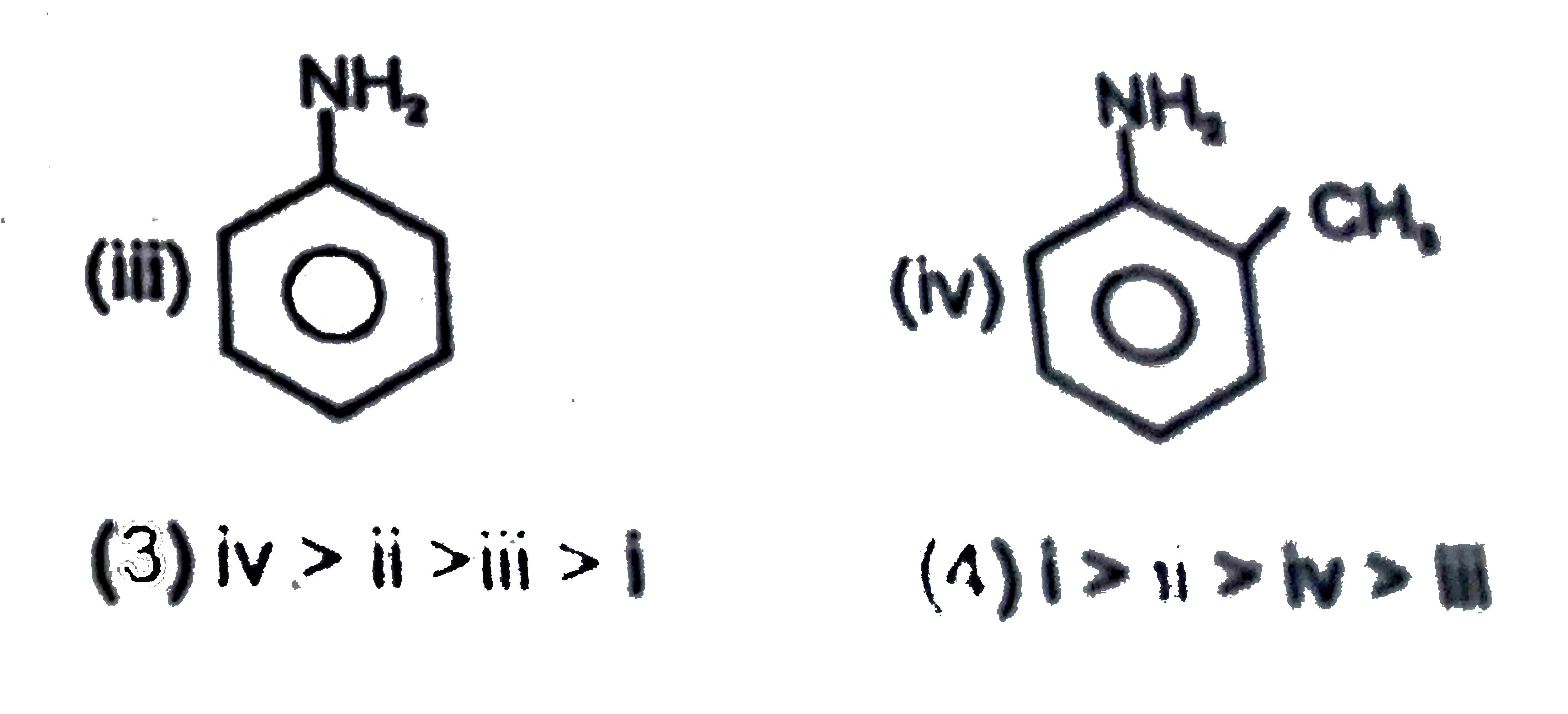Which of the following is the correct increasing order of boiling point of following compounds ?
I CH3−CH2−CH2OH, II CH3−CH∣OH−CH3 , III CH3−O−CH2−CH3
II<I<III
III<II<I
I<II<III
II<III<I
The correct Answer is:B
To determine the correct increasing order of boiling points for the given compounds, we will analyze each compound based on the factors that influence boiling points, such as molecular weight, branching, and hydrogen bonding.
Step 1: Identify the Compounds
The compounds given are:
1. I: CH₃−CH₂−CH₂OH (1-propanol)
2. II: CH₃−CH(OH)−CH₃ (2-propanol)
3. III: CH₃−O−CH₂−CH₃ (ethyl methyl ether)
Step 2: Analyze Molecular Weight
All three compounds have similar molecular weights, which means that the molecular weight factor will not significantly differentiate their boiling points.
Step 3: Assess Hydrogen Bonding
- Compound I (1-propanol): This compound has a hydroxyl (-OH) group, allowing for hydrogen bonding. Hydrogen bonding typically increases boiling points.
- Compound II (2-propanol): This compound also has a hydroxyl (-OH) group and can participate in hydrogen bonding, but it is branched, which can lower the boiling point compared to straight-chain alcohols.
- Compound III (ethyl methyl ether): This compound lacks a hydroxyl group and therefore cannot form hydrogen bonds, leading to a lower boiling point.
Step 4: Consider the Effect of Branching
- Compound I (1-propanol): No branching, which generally leads to a higher boiling point.
- Compound II (2-propanol): Has branching (due to the presence of the -OH group on the second carbon), which decreases the boiling point compared to straight-chain alcohols.
- Compound III (ethyl methyl ether): No hydrogen bonding and has a branched structure, leading to the lowest boiling point.
Step 5: Compare the Boiling Points
Based on the analysis:
- Compound III (ethyl methyl ether) will have the lowest boiling point due to the absence of hydrogen bonding.
- Compound II (2-propanol) will have a higher boiling point than Compound III but lower than Compound I due to branching.
- Compound I (1-propanol) will have the highest boiling point because it has no branching and can form hydrogen bonds.
Conclusion: Increasing Order of Boiling Points
The correct increasing order of boiling points is:
III < II < I
Final Answer
The increasing order of boiling points is: III < II < I (or 3 < 2 < 1).
---
The compounds given are:
1. I: CH₃−CH₂−CH₂OH (1-propanol)
2. II: CH₃−CH(OH)−CH₃ (2-propanol)
3. III: CH₃−O−CH₂−CH₃ (ethyl methyl ether)
All three compounds have similar molecular weights, which means that the molecular weight factor will not significantly differentiate their boiling points.
- Compound I (1-propanol): This compound has a hydroxyl (-OH) group, allowing for hydrogen bonding. Hydrogen bonding typically increases boiling points.
- Compound II (2-propanol): This compound also has a hydroxyl (-OH) group and can participate in hydrogen bonding, but it is branched, which can lower the boiling point compared to straight-chain alcohols.
- Compound III (ethyl methyl ether): This compound lacks a hydroxyl group and therefore cannot form hydrogen bonds, leading to a lower boiling point.
- Compound I (1-propanol): No branching, which generally leads to a higher boiling point.
- Compound II (2-propanol): Has branching (due to the presence of the -OH group on the second carbon), which decreases the boiling point compared to straight-chain alcohols.
- Compound III (ethyl methyl ether): No hydrogen bonding and has a branched structure, leading to the lowest boiling point.
Based on the analysis:
- Compound III (ethyl methyl ether) will have the lowest boiling point due to the absence of hydrogen bonding.
- Compound II (2-propanol) will have a higher boiling point than Compound III but lower than Compound I due to branching.
- Compound I (1-propanol) will have the highest boiling point because it has no branching and can form hydrogen bonds.
The correct increasing order of boiling points is:
III < II < I
The increasing order of boiling points is: III < II < I (or 3 < 2 < 1).
Topper's Solved these Questions
- BOOK - AAKASH INSTITUTECHAPTER - ALCOHOLS, PHENOLS AND ETHERSEXERCISE - Assignment Section - C (Previous Years questions)25videos
ALCOHOLS, PHENOLS AND ETHERS
- BOOK - AAKASH INSTITUTECHAPTER - ALCOHOLS, PHENOLS AND ETHERSEXERCISE - Assignment Section - C (Questions asked Prior to medical Ent. Exams. 2005)13videos
ALCOHOLS, PHENOLS AND ETHERS
- BOOK - AAKASH INSTITUTECHAPTER - ALCOHOLS, PHENOLS AND ETHERSEXERCISE - Assignment Section - A (Objective type questions)45videos
ALCOHOLS, PHENOLS AND ETHERS
- BOOK - AAKASH INSTITUTECHAPTER - ALCOHOLS, PHENOLS AND ETHERS EXERCISE - Try Yourself5videos
ALCOHOLS, PHENOLS AND ETHERS
Similar Questions
Knowledge Check
- Question 1 - Select One
The correct reactivity order of alcohols towards H−X will be
(I) CH2=CH−OH (II) (III) CH3−CH2OH (IV) CH3−CH∣OH−CH3AII>I>III>IVBIV>III>II>ICII>IV>I>IIIDII>IV>III>I
(III) CH3−CH2OH (IV) CH3−CH∣OH−CH3AII>I>III>IVBIV>III>II>ICII>IV>I>IIIDII>IV>III>I - Question 2 - Select One
CH3CH2CH2−OH and CH3−CH∣OH−CH3 shows which type of isomerism
AChain isomersBposition isomersCFunctional isomersDMetamers - Question 3 - Select One
Following compounds are given
(i) CH3CH2OH
(ii) CH3COCH3
(iii) CH3−C∣CH3HOH
(iv) CH3OHA(i), (iiii) and (iv)Bonly (ii)C(i), (ii) and (iii)D(i) and (ii)
Identify the correct order of boiling point of the following compounds :
CH3CH2CH2CH2OH1 CH3CH2CHO2 CH3CH2CH2COOH3View SolutionIndentify the correct order of boiling points of the following compounds CH3CH2CH2OHI, CH3CH2CH2CHOII, CH3CH2CH2COOHIII
View SolutionIdentify the correct order of boiling points of the following compounds: CH3CH2CH2CH2OH1, CH3CH2CH2CHO2
CH3CH2CH2COOH3View SolutionIdentify the correct order of boiling points of the following compounds.
CH3CH2CH2CH2OH(A),CH3CH2CH2CHO(B),CH3CH2CH2COOH(C).View SolutionWhich of the following is correct order of basic strength for the given compounds ?
(i)CH3−CH3−C−NH2∣∣NH (ii)CH3−C−CH3∣∣NH
 View Solution
View Solution

